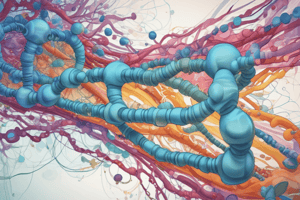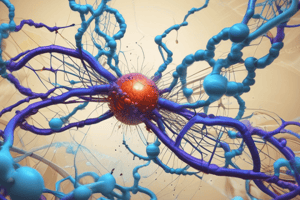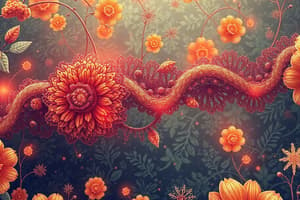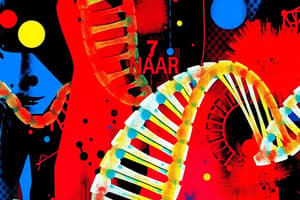Podcast
Questions and Answers
Which enzyme is involved in the riboflavin biosynthesis pathway and is regulated by a FMN riboswitch?
Which enzyme is involved in the riboflavin biosynthesis pathway and is regulated by a FMN riboswitch?
- RibA
- RibCF
- RibH
- RibE (correct)
What is the role of GTP cyclohydrolase II (RibA) in the riboflavin biosynthesis pathway?
What is the role of GTP cyclohydrolase II (RibA) in the riboflavin biosynthesis pathway?
- Inhibits the formation of FMN riboswitch
- Catalyzes an early step in the pathway (correct)
- Regulates the expression of RibE
- Is not involved in the pathway
What happens when FMN binds to the riboswitch?
What happens when FMN binds to the riboswitch?
- Inhibits translation only
- Causes premature termination of gene expression (correct)
- Stimulates gene expression
- Has no effect on gene expression
Which genes are part of the single transcription unit regulated by the FMN riboswitch?
Which genes are part of the single transcription unit regulated by the FMN riboswitch?
What is the utility of the FMN riboswitch in the pathogenic bacterium M. tuberculosis?
What is the utility of the FMN riboswitch in the pathogenic bacterium M. tuberculosis?
Which statement accurately describes the effect of FMN binding to its target?
Which statement accurately describes the effect of FMN binding to its target?
Which analogs inhibit the synthesis of vitamin B2 and FMN?
Which analogs inhibit the synthesis of vitamin B2 and FMN?
What is the effect of inhibitors of FMS synthesis on the pathogenic bacterium M. tuberculosis?
What is the effect of inhibitors of FMS synthesis on the pathogenic bacterium M. tuberculosis?
What happens in the absence of FMN?
What happens in the absence of FMN?
Which enzyme catalyzes the formation of 3,4-dihydroxy2-butanone-4-phosphate in the riboflavin biosynthesis pathway?
Which enzyme catalyzes the formation of 3,4-dihydroxy2-butanone-4-phosphate in the riboflavin biosynthesis pathway?
Which type of gene expression regulation will be discussed in today's lecture?
Which type of gene expression regulation will be discussed in today's lecture?
What is the key benefit of posttranscriptional control of gene expression?
What is the key benefit of posttranscriptional control of gene expression?
Which example is used to illustrate regulation via translational feedback?
Which example is used to illustrate regulation via translational feedback?
What is the main focus of the article 'Antibiotic Resistance: Current Perspectives'?
What is the main focus of the article 'Antibiotic Resistance: Current Perspectives'?
In bacteria, what is increased demand for protein synthesis met by?
In bacteria, what is increased demand for protein synthesis met by?
Which factor operates at the transcriptional and translational level to regulate riboflavin biosynthesis?
Which factor operates at the transcriptional and translational level to regulate riboflavin biosynthesis?
What was discussed in the last lecture regarding gene expression regulation in bacteria?
What was discussed in the last lecture regarding gene expression regulation in bacteria?
Which operon was mentioned in the last lecture for positive and negative regulation with different proteins?
Which operon was mentioned in the last lecture for positive and negative regulation with different proteins?
What is the source of the article 'The ribB FMN riboswitch from Escherichia coli'?
What is the source of the article 'The ribB FMN riboswitch from Escherichia coli'?
Which section of the text should be referred to for further details on post-transcriptional regulation of gene expression?
Which section of the text should be referred to for further details on post-transcriptional regulation of gene expression?
What percentage of total cellular proteins can ribosomal proteins make up in rapidly growing cells?
What percentage of total cellular proteins can ribosomal proteins make up in rapidly growing cells?
How many genes encode r-proteins?
How many genes encode r-proteins?
Where do riboswitches exist within mRNA?
Where do riboswitches exist within mRNA?
What controls gene expression by inhibiting translation when [vitamin B1] is high?
What controls gene expression by inhibiting translation when [vitamin B1] is high?
Which molecule causes the glmS riboswitch to degrade itself?
Which molecule causes the glmS riboswitch to degrade itself?
How are riboswitches classified?
How are riboswitches classified?
What is one of the mechanisms through which many bacteria are developing resistance to antibiotics?
What is one of the mechanisms through which many bacteria are developing resistance to antibiotics?
Which riboswitch controls the expression of genes involved in the biosynthesis of riboflavin (vitamin B2)?
Which riboswitch controls the expression of genes involved in the biosynthesis of riboflavin (vitamin B2)?
What is the function of one r-protein in each operon?
What is the function of one r-protein in each operon?
What is the role of riboswitch-regulated mRNAs' long sequences upstream from the translation start site?
What is the role of riboswitch-regulated mRNAs' long sequences upstream from the translation start site?
True or false: The FMN riboswitch is involved in the regulation of the riboflavin biosynthesis pathway in M. tuberculosis.
True or false: The FMN riboswitch is involved in the regulation of the riboflavin biosynthesis pathway in M. tuberculosis.
True or false: In the presence of FMN, gene expression is prematurely terminated due to the binding of FMN to the riboswitch.
True or false: In the presence of FMN, gene expression is prematurely terminated due to the binding of FMN to the riboswitch.
True or false: Roseoflavin and Ribocil-C promote the synthesis of vitamin B2 and FMN.
True or false: Roseoflavin and Ribocil-C promote the synthesis of vitamin B2 and FMN.
True or false: The FMN riboswitch only regulates transcription and not translation.
True or false: The FMN riboswitch only regulates transcription and not translation.
True or false: The ribDG-E-AB-H transcriptional unit is regulated by the FMN riboswitch.
True or false: The ribDG-E-AB-H transcriptional unit is regulated by the FMN riboswitch.
Flashcards are hidden until you start studying
Study Notes
Riboswitches and Antibiotic Resistance
- Ribosomal proteins can make up to 45% of total cellular proteins in rapidly growing cells
- Bacteria coordinate the synthesis of the ribosomal components r-proteins r-RNAs
- There are 52 genes encoding r-proteins, present in ~20 operons, with one r-protein in each operon functioning as a translational repressor
- Riboswitches exist within the 5′ untranslated region (5′UTR) of mRNA and can function at the level of transcription and translation
- The thiamine pyrophosphate (TPP)–binding riboswitch controls gene expression by inhibiting translation when [vitamin B1] is high
- Riboswitches can affect mRNA stability, such as the glmS riboswitch which degrades itself on binding of GlcN6-P
- Riboswitches can discriminate between chemically related molecules based on atomic charge, stereochemistry, and the presence or absence of particular functional groups
- Riboswitches can be very specific to their ligands
- Riboswitch-regulated mRNAs have unusually long sequences upstream from the translation start site that are necessary to form the riboswitch
- There are over 15 classes of Riboswitches, classified based on ligand type and secondary structure
- Many bacteria are developing resistance to antibiotics through mechanisms such as decreasing antibiotic influx, increasing antibiotic efflux, degrading or modifying antibiotics, protecting antibiotic targets, and producing alternative proteins
- The FMN riboswitch controls the expression of genes involved in the biosynthesis of riboflavin (vitamin B2) and is related to antibiotic resistance through the inhibition of vitamin B2 and FMN synthesis.
Studying That Suits You
Use AI to generate personalized quizzes and flashcards to suit your learning preferences.




